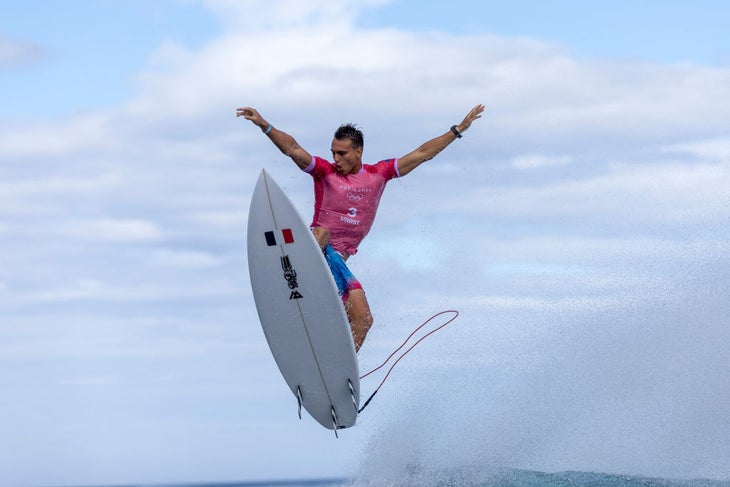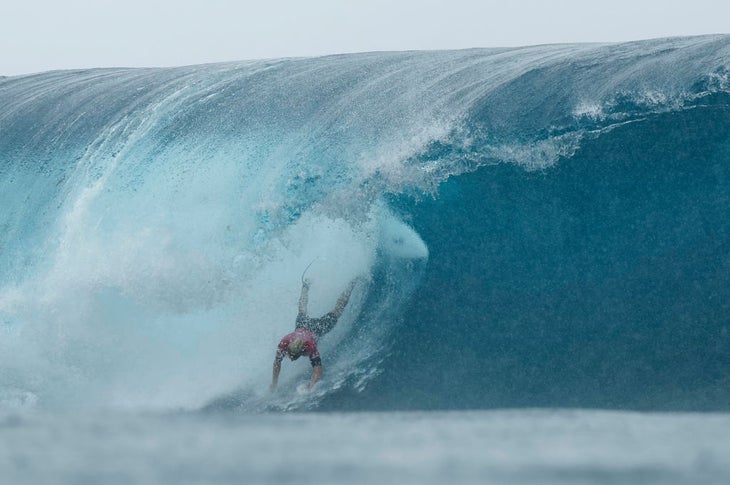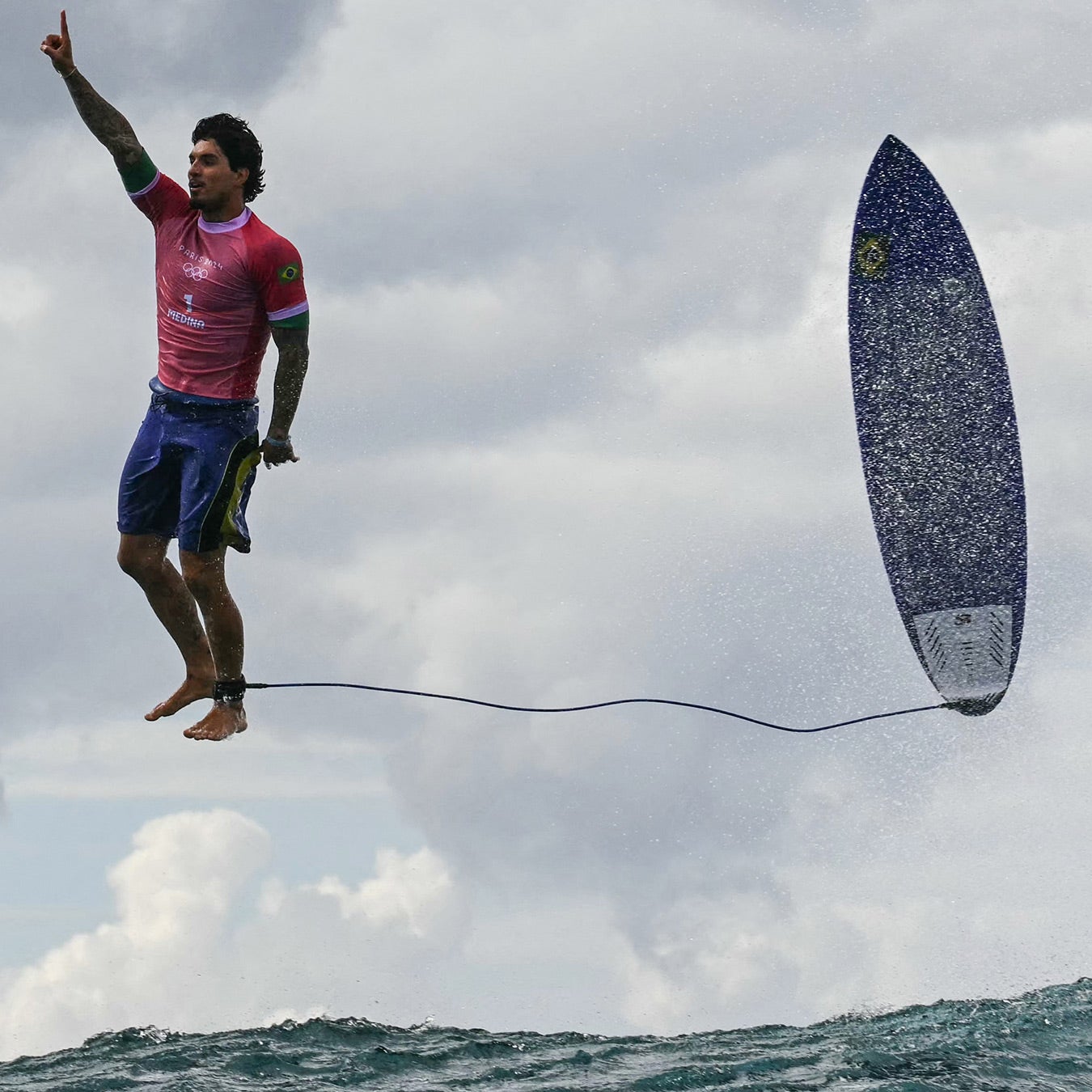By now you’ve probably seen the image of Brazilian surfer Gabriel Medina suspended in midair like a superhero, his surfboard floating behind him instead of a cape. The viral photo, which was snapped on Monday at Teahupo’o, the Olympic surfing venue in Tahiti, is already being called the defining image of the 2024 Summer Games.
Whether you surf or not, it’s hard to look away from this photograph. The composition of the shot is freakishly perfect. Medina and his board hover in the air, both vertical and nearly parallel. The leash that connects them is suspended across the diamond blue ocean, and the backdrop of fluffy white clouds makes the surfer and his board stand out almost like they were in a painting. Medina’s finger raised in the air is so symbolic that you don’t need to have seen his ride to know that he was victorious.
But I did want to see the wave. Don’t get me wrong, the gravity-defying shot is unreal. But so was Medina’s ride prior to the shot. The three-time world champion dropped into a ten-foot wave at Teahupo’o, got deep into the barrel, and then skyrocketed into the air, his index finger raised, declaring himself number one.
O mega tubo que o Gabriel Medina pegou na eliminatória do surf nos de 🤩
— Jeff Nascimento (@jnascim)
As a lifelong surf fanatic, I’m typically thrilled to see the sport captivate a global and mainstream audience. Wave conditions for Monday’s third round of the men’s surfing finals were all-time. In fact, photographers snapped plenty of epic images of surfers actually riding—and in some cases wiping out—on barreling waves: Local Tahitian surfer Kauli Vaast flexed as he got spit out of a super deep tube ride; Aussie Ethan Ewing went head first over the falls in terrifying fashion; and Medina sped on his tippy toes down the face of the wave he so theatrically kicked out of.
After seeing the Medina photo, one friend actually asked me if surfers are scored on their “dismounts” similarly to gymnasts. No, I told her, Medina’s 9.90 score—the highest single-wave mark awarded since surfing became an Olympic sport in Tokyo in 2020—had nothing to do with how he exited the wave at the end of his run, a maneuver called a “kickout.” Her question made me realize that the majority of people to see the photograph probably know very little about surfing, and the image certainly isn’t helping educate them on the skill and athleticism required to not just survive a wave as heavy as Teahupo’o, but to ride it with style.

I felt somewhat disappointed when I realized that this iconic photograph will forever be linked to Olympic surfing. Why? This year’s Olympic surfing competition is being held at a world-class break that was miraculously blessed with good conditions for the event. Tom Servais, a photographer who has spent decades shooting the world’s best surfers at the most exciting breaks, described the waves on Monday morning as “a gift.” In surfing, unlike most Olympic sports, the athlete isn’t the only one who has a say in the effort, risk, and difficulty of their performance. Conditions are dictated by Mother Nature. And on Monday, Teahupo’o, one of the most dangerous waves in the world, put on an awesome and unexpected display of raw power. Solid ten-foot sets unloaded deep, throaty barrels onto shallow sharp reef.
Perhaps that’s why the surf world has been quick to mock the Medina shot—I’ll admit, the is pretty hilarious. But we shouldn’t write off the significance of the mesmerizing moment snapped by Jérôme Brouillet, a photographer for Agence France-Presse. Servais said he wished he took that shot. “It won’t be iconic in the hardcore surfing world, but I think it is iconic,” he said. While it may not represent the immaculate conditions of Teahupo’o on that day, it does capture the competitive spirit that fuels the Olympics and the elation an athlete feels when they deliver a near flawless performance. If you were watching that round live, you would have seen Medina come out of the barrel flashing his hands wide open to communicate a perfect 10 score (two of the five judges agreed). When Medina followed that gesture with the Number 1, my initial reaction was to pass it off as cockiness. But after talking to some surfing industry veterans, I now view Medina’s reaction differently.
Servais, who has been shooting greats like Tom Curran and the late Andy Irons since the seventies, pointed out that in the early days before social media, the Brazilian surfers always made claims—colorful gestures similar to an NFL player’s end zone dance or a tennis player’s fist pump—after a great ride. “In the old days, before social media, it was uncool to claim,” he says. “But the Brazilians are super passionate and now, with social media, it’s a way to broadcast your national pride.”

If you flip through other images taken on Monday, you see a lot of athletes with their arms raised, gaze to the heavens, or hands pressed together, heads bowed in prayer. “Celebrating a good score could be interpreted not just as an athletic achievement but also, or more so, as the athlete being thankful that nature provided them with a wave that could be executed properly,” said surf photographer Matt Paul Catalano.
Ross Phillips, an Australian surf coach and founder of travel company Tropicsurf, confirmed I wasn’t alone in my initial reaction. “The photo is almost Christ-like,” he said. “A lot of people hate him because he’s so confident and cocky, but he is a competitive animal and has the best record of anyone at Teahupo’o. That gesture in the photo shows his level of self-belief and that’s really important to win a medal in those conditions.”
Former pro American surfer CJ Hobgood drove it home for me when he reminded me of Medina’s Olympic backstory. “This photo is about how Gabriel had to get to the Olympics,” he said. The Brazilian narrowly missed medaling in the inaugural men’s Olympics surfing contest in Tokyo four years ago, to Japan’s Kanoa Igarashi, who he faced off with, and defeated, in this year’s round three.
Hobgood reminded me that Medina had to work hard to even qualify for the 2024 Games. He had to travel to the ISA World Surfing Games in Puerto Rico in February—the swell was not ideal—and then win the event to earn Brazil a third men’s spot for the Olympics—the spot that he took.
“This photo shows a full manifestation of the road less traveled, the long way home, and he’s running off fuel very few are running off in the entire Paris 2024 Olympics,” Hobgood said.
When you use that as context, you can’t help but cheer “Go Medina!”


